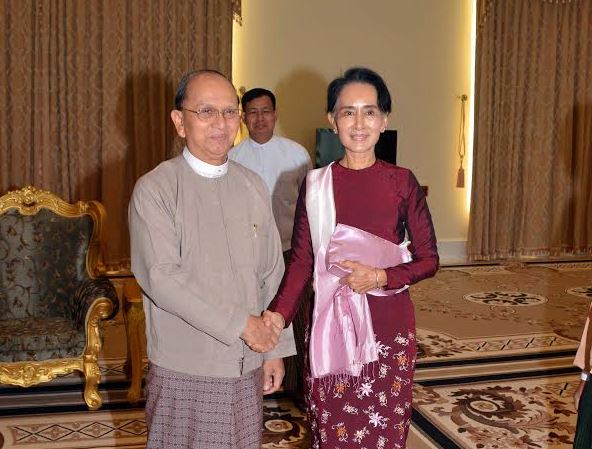When US President Barack Obama hosts a meeting of Southeast Asian leaders in California this week, his Burmese counterpart Thein Sein will be notably absent.
Burma‘s outgoing president abruptly pulled out of the summit as secretive talks continued between his country’s powerful military and the incoming government of Nobel laureate Aung San Suu Kyi.
For his admirers, a smooth transition of power would seal Thein Sein’s legacy as the former general who led Burma‘s dramatic emergence from nearly half a century of military dictatorship.
He freed political prisoners, scrapped censorship, oversaw a historic election and repaired relations with the West, turning Burma from a global pariah into a buzzing destination for tourists, investors and world leaders.
On 31 March, he will pass the unfinished task of handing power to a National League for Democracy (NLD) government led by Suu Kyi, his wildly popular political rival, who in November won the country’s first credible general election in 25 years.
Despite fears of fraud, the election ran smoothly and Thein Sein’s Union Solidarity and Development Party (USDP), dominated by former military officers, accepted a crushing defeat.
But critics say Thein Sein, who gave no reason for cancelling his attendance at the California summit on Monday and Tuesday, did little to tackle his country’s profound poverty or the religious tensions that regularly erupted into deadly violence.
Nor did he challenge the military, whose abiding influence over every aspect of Burmese – politics, bureaucracy, business – poses a major challenge to Suu Kyi’s fledgling administration.
“Thein Sein will be remembered as the president who really turned Myanmar around,” said Richard Horsey, a Rangoon-based analyst and former United Nations official in Burma.
“His administration has been far from perfect, but his legacy will be an enduring one.”
Former junta leader Than Shwe appointed him prime minister in 2007, the same year the military government brutally suppressed pro-democracy protests led by Buddhist monks.
Four years later, after winning a general election marred by vote-rigging allegations and boycotted by Suu Kyi’s NLD, Thein Sein became president of a nominally civilian government packed with former soldiers.
Looking west
He set the tone for his presidency with his abrupt suspension in September 2011 of a $3.6-billion, China-backed dam at Myitsone, in northern Burma, source of the mighty Irrawaddy River.
The dam had drawn protests on both environmental and patriotic grounds, and suspending it boosted Thein Sein’s popularity among his 51 million people.
It also signalled that the preferential treatment China had received during the years of junta rule was over.
A bookish-looking 70-year-old, Thein Sein’s leadership style is “low-key, people-centred, even humble”, said analyst Horsey.
Suu Kyi was less impressed. She first met Thein Sein in the capital, Naypyitaw, in August 2011, eight months after she was freed from house arrest. For an ex-general struggling for global credibility, it was a pivotal encounter.
Suu Kyi pronounced Thein Sein “sincere” about reforming Burma. That endorsement paved the way for a visit by Hillary Clinton, then US Secretary of State, in November and an end to most Western sanctions the following year.
Thein Sein held many more closed-door meetings with Suu Kyi, but their relationship would sour.
When asked by Reuters in April 2014 whether she still thought Thein Sein was sincere, Suu Kyi replied: “No. Because if he had been sincere about reform then we would be much further ahead than we are.”
Presidential spokesman Ye Htut described Thein Sein as an intensely private man whose chief concern was Burma‘s stability.
This meant putting issues such as corruption on the backburner so as “not to rock the boat”, said Ye Htut.
Critics say it also meant preserving the military’s powers – and ignoring its well-documented human rights abuses – in the name of national reconciliation.
The military, which holds a quarter of parliamentary seats and key ministerial posts, remained outside civilian control under Thein Sein.
Religious strife
Thein Sein was also widely criticised for failing to halt religious violence that killed hundreds of people, mostly Muslims, and caused lasting damage to relations with majority Buddhists.
He was condemned for Burma‘s treatment of the Rohingya, a Muslim minority forced to live in squalid camps in western Burma, and for the passage of four so-called “race and religion protection” laws championed by radical Buddhist monks.
The laws, which rights groups said discriminated against Muslims and women, made Thein Sein a “hero” to Buddhist extremists, said Wai Wai Nu, a Rohingya activist and former political prisoner.
[related]
“A democratic president should not be biased towards one religion,” she told Reuters.
Suu Kyi was also criticised for failing to speak up for the Rohingya.
Thein Sein’s most ambitious plan was to bring peace to a nation fractured by decades of fighting between the military and dozen of ethnic rebel armies.
But only eight of 15 armed groups signed a nation ceasefire in October, with many of the most powerful staying away. The fighting continues.



